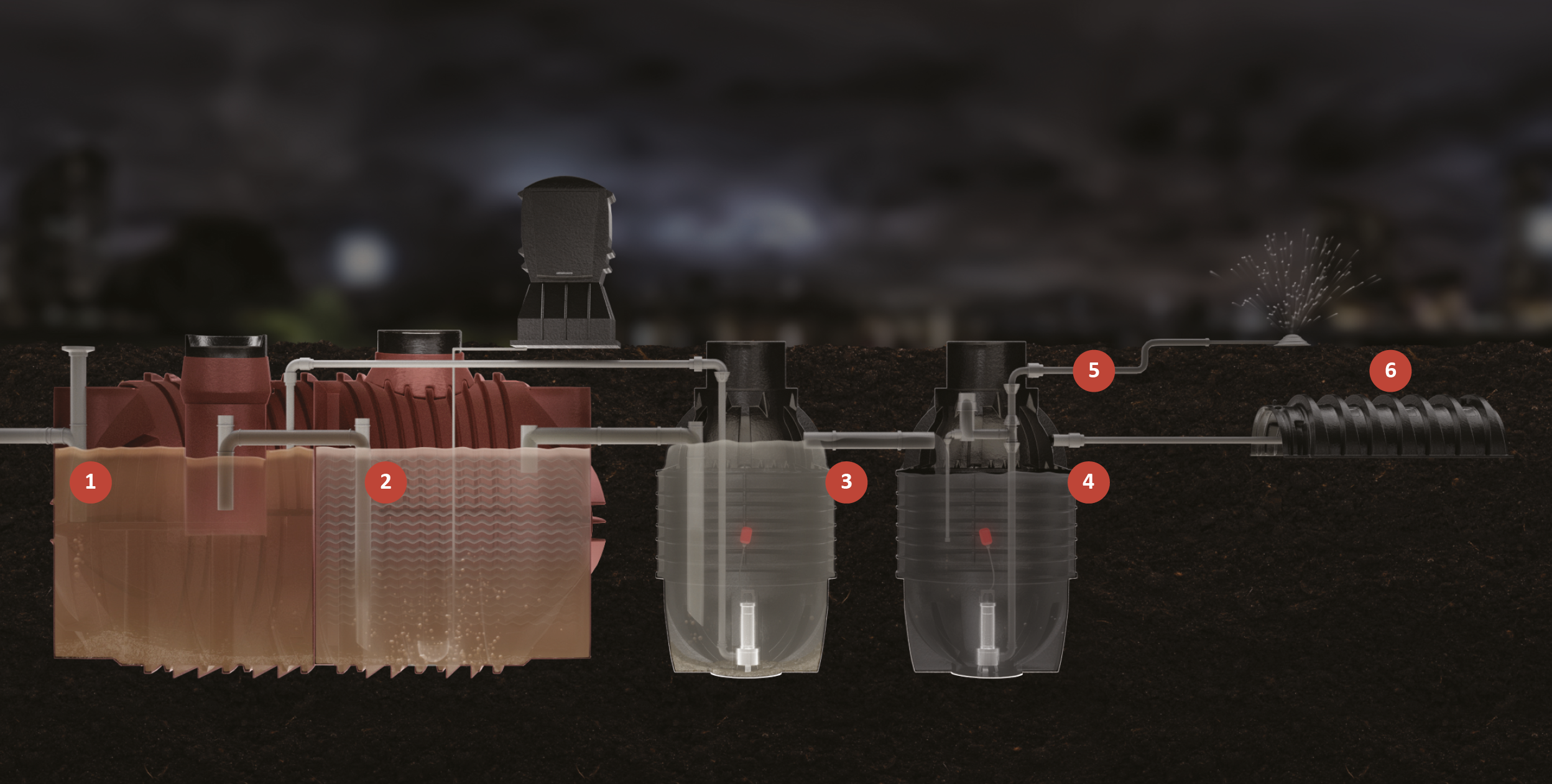Wastewater Treatment Plants
Our wastewater treatment plants provide you the opportunity to better manage,
dispose of, or recycle your wastewater in a safe, reliable and sustainable way.
The purpose of an on-site wastewater treatment plant
The purpose of a water and wastewater treatment system or on-site sewage treatment plant is to receive all wastewater and treat it to a specified quality, typically so that it can be safely re-used for non-potable applications, returned to the environment without any negative impact, or further treated for potable re-use.
The associated treatment phases
Primary treatment
Utilises septic tanks as part of the sewage treatment process to remove organic material.
Biological treatment
Deploys the Calcamite configured Bio-reactor to achieve aerobic oxidation of organic compounds via bacterial growth.
Disinfection and storage
Eliminates pathogenic bacteria in the treated wastewater, rendering it safe for re-use/discharge.
Soakaway drainage system
Can be deployed to discharge surplus wastewater safely into the sub-soil.
How it works

Primary treatment
Sewage enters the septic tank (depending on the size of the plant, the septic tank can have multiple chambers which permit settlement as well as surplus sewage sludge storage). Within the septic tank, gross solids settle out under gravity and are gradually broken down by anaerobic digestion. This natural separation process allows a relatively solid-free effluent to be passed into the sewage treatment plant process stream.
Note: the septic tanks are designed for 24-hour retention and are modular which allows them to easily be scaled should additional capacity be required.
Biological treatment
The next step in the wastewater treatment process is the submerged Bio-reactor where the biological treatment of sewage takes place.
It consists of a tank that is filled with a fixed film plastic media that serves as a surface area for biomass to attach to. The tank is aerated to allow for aerobic bacterial sewage treatment (bacteria that feed on the organic compounds present in the wastewater).
If designed, constructed, and operated correctly, these biological sewage treatment systems can produce an effluent that meets the general authorisation limits standard of the National Water Act 36 of 1998.
Final settlement
The treated sewage flows into the final clarifier. Here, clear water rises to the surface of the tank and is discharged via the outlet into a disinfection chamber and the settled sludge is recycled to the septic tank.
Disinfection and storage
The disinfection process in wastewater treatment is the final stage and ensures any remaining pathogens are killed. This is either done by using chlorine, ozone or UV radiation.
Re-use of the processed water
Non-potable applications - the treated wastewater can either be re-used for non-potable applications such as irrigation; or safely returned to the environment via a stormwater system or soakaway in accordance with local regulations.
Potable applications - tertiary treatment can also be added to further recycle the treated wastewater for potable reuse if required.
Soakaway drainage system
The overflow is connected to a soakaway (a drain field that allows the treated wastewater to percolate into the ground) should the tank get too full or when system maintenance is required.
Maintenance
A maintenance and operation manual is provided during the commissioning phase and typically consists of annual desludging of the septic tank, servicing of mechanical equipment, and monthly replacement of chlorine tablets (if applicable). The plants need to be inspected on a regular basis to ensure all components are operational.
Ideal applications
Where waterborne, on-site sanitation is required.
When wastewater is to be reused to limit waste and/or reduce water usage.
When the desired outcome is to go off-grid with all wastewater.
Key differentiators
Flexibility
Options for above-ground, below-ground, or containerised installations depending on site conditions.
Scalability
Modular nature of our plants allows for easy scaling and caters to both residential on-site water treatment systems and large-scale commercial and light-industrial needs.
Efficiency
Rapid installation, easy operation and maintenance, and high efficacy in reducing BOD and COD levels.
Durability
Designed for a lifespan of approximately 30 years.
Order your custom plant today!
Start by sharing your requirements, and we'll provide a preliminary design and cost estimate (this may involve a site visit for more complex plants). Upon approval, we'll finalise the design and quotation.
Wastewater treatment is simplified with our comprehensive services which include:
- Customised wastewater treatment plant designs.
- Manufacturing of specialised tanks and complete plant assembly.
- Installation guidance or direct installation services.
- Supervised installation and compulsory commissioning.
- Post-commissioning inspections and tests.
- Maintenance plans and optional SLAs.
